ENC3CRC Essay: The Creative is Critical and the Critical is Creative
VerifiedAdded on 2023/06/04
|12
|3460
|54
Essay
AI Summary
This essay explores the dynamic relationship between creative and critical thinking and their combined impact on knowledge generation. It begins by defining these two essential modes of thought, highlighting how creative thinking involves the generation of new and original ideas, while critical thinking involves questioning assumptions and validating existing beliefs. The essay emphasizes that both forms of thinking are crucial for producing acceptable and novel knowledge, particularly within educational contexts, where students learn to evaluate information, solve problems, and consider alternatives. It discusses the application of these thinking skills in addressing contemporary challenges, fostering innovation, and developing adaptable, enterprising individuals. The essay also delves into the practical aspects of creative and critical thinking, including concept formation, intellectual flexibility, and the importance of applying knowledge to real-world problems. Furthermore, it examines how curricular structures and assessment methods can either encourage or hinder the development of these skills, with a call for more flexible curricula and process-based assessment. The essay concludes by emphasizing the importance of curiosity, metaphoric thinking, and the gathering of diverse information in cultivating creative and critical thinking abilities, offering practical advice for students and scholars alike.
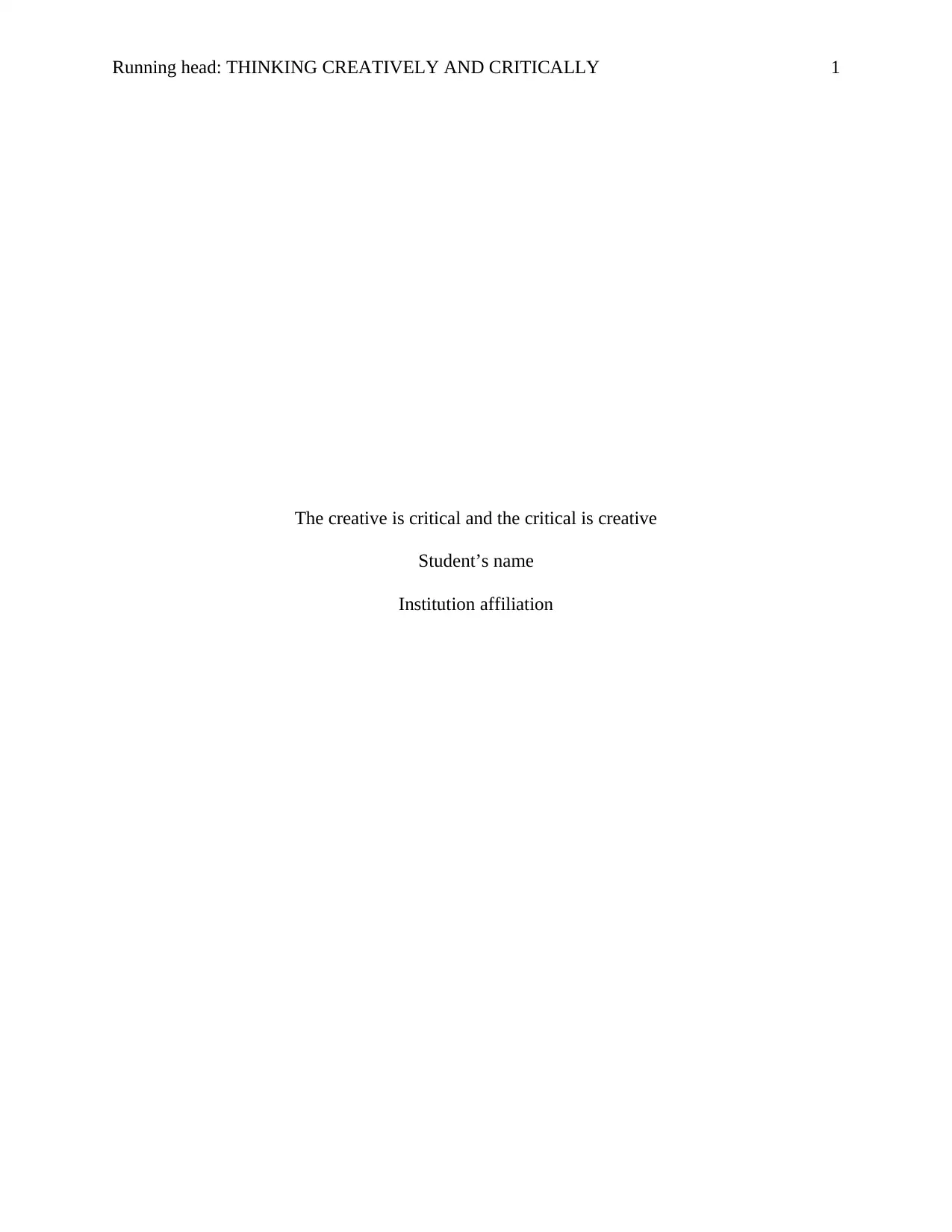
Running head: THINKING CREATIVELY AND CRITICALLY 1
The creative is critical and the critical is creative
Student’s name
Institution affiliation
The creative is critical and the critical is creative
Student’s name
Institution affiliation
Paraphrase This Document
Need a fresh take? Get an instant paraphrase of this document with our AI Paraphraser
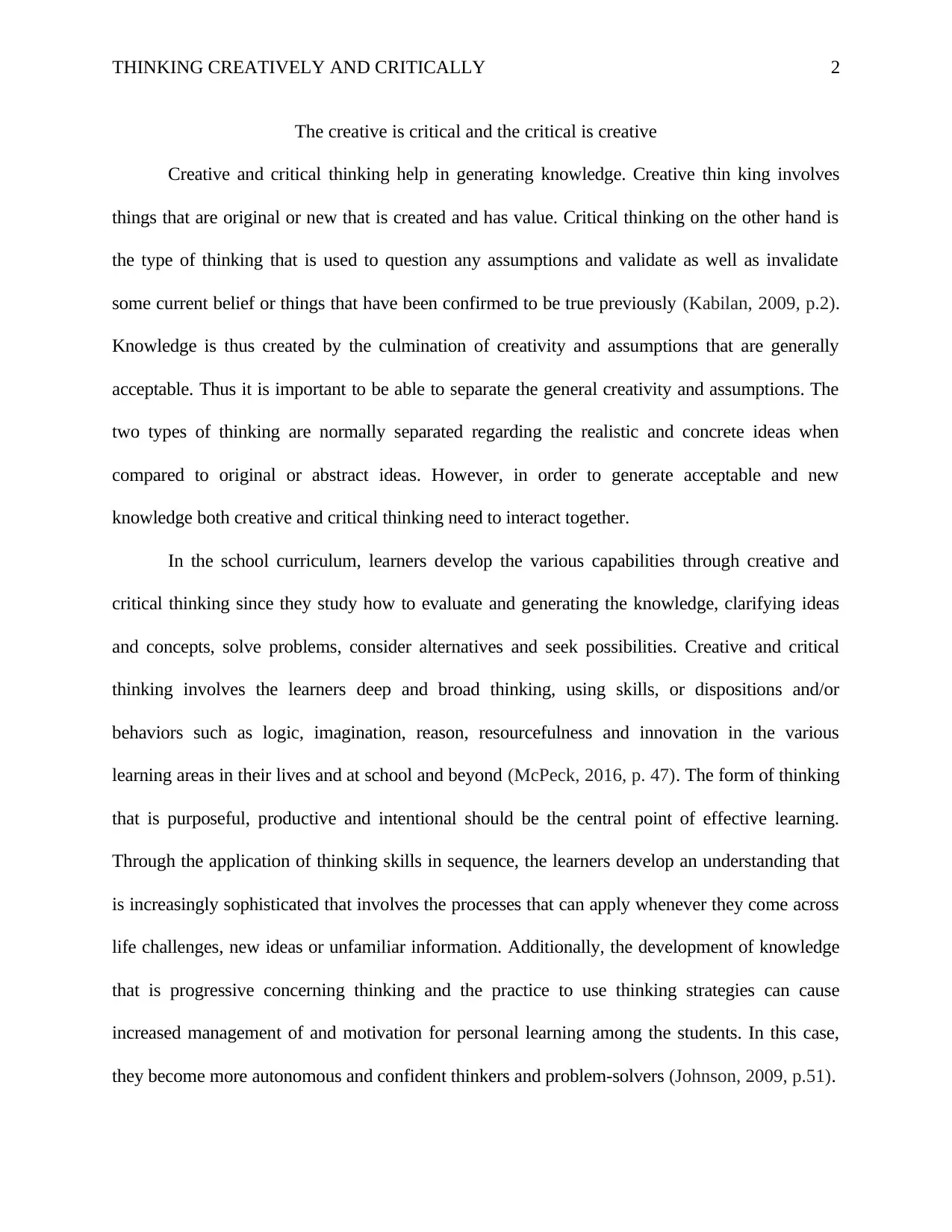
THINKING CREATIVELY AND CRITICALLY 2
The creative is critical and the critical is creative
Creative and critical thinking help in generating knowledge. Creative thin king involves
things that are original or new that is created and has value. Critical thinking on the other hand is
the type of thinking that is used to question any assumptions and validate as well as invalidate
some current belief or things that have been confirmed to be true previously (Kabilan, 2009, p.2).
Knowledge is thus created by the culmination of creativity and assumptions that are generally
acceptable. Thus it is important to be able to separate the general creativity and assumptions. The
two types of thinking are normally separated regarding the realistic and concrete ideas when
compared to original or abstract ideas. However, in order to generate acceptable and new
knowledge both creative and critical thinking need to interact together.
In the school curriculum, learners develop the various capabilities through creative and
critical thinking since they study how to evaluate and generating the knowledge, clarifying ideas
and concepts, solve problems, consider alternatives and seek possibilities. Creative and critical
thinking involves the learners deep and broad thinking, using skills, or dispositions and/or
behaviors such as logic, imagination, reason, resourcefulness and innovation in the various
learning areas in their lives and at school and beyond (McPeck, 2016, p. 47). The form of thinking
that is purposeful, productive and intentional should be the central point of effective learning.
Through the application of thinking skills in sequence, the learners develop an understanding that
is increasingly sophisticated that involves the processes that can apply whenever they come across
life challenges, new ideas or unfamiliar information. Additionally, the development of knowledge
that is progressive concerning thinking and the practice to use thinking strategies can cause
increased management of and motivation for personal learning among the students. In this case,
they become more autonomous and confident thinkers and problem-solvers (Johnson, 2009, p.51).
The creative is critical and the critical is creative
Creative and critical thinking help in generating knowledge. Creative thin king involves
things that are original or new that is created and has value. Critical thinking on the other hand is
the type of thinking that is used to question any assumptions and validate as well as invalidate
some current belief or things that have been confirmed to be true previously (Kabilan, 2009, p.2).
Knowledge is thus created by the culmination of creativity and assumptions that are generally
acceptable. Thus it is important to be able to separate the general creativity and assumptions. The
two types of thinking are normally separated regarding the realistic and concrete ideas when
compared to original or abstract ideas. However, in order to generate acceptable and new
knowledge both creative and critical thinking need to interact together.
In the school curriculum, learners develop the various capabilities through creative and
critical thinking since they study how to evaluate and generating the knowledge, clarifying ideas
and concepts, solve problems, consider alternatives and seek possibilities. Creative and critical
thinking involves the learners deep and broad thinking, using skills, or dispositions and/or
behaviors such as logic, imagination, reason, resourcefulness and innovation in the various
learning areas in their lives and at school and beyond (McPeck, 2016, p. 47). The form of thinking
that is purposeful, productive and intentional should be the central point of effective learning.
Through the application of thinking skills in sequence, the learners develop an understanding that
is increasingly sophisticated that involves the processes that can apply whenever they come across
life challenges, new ideas or unfamiliar information. Additionally, the development of knowledge
that is progressive concerning thinking and the practice to use thinking strategies can cause
increased management of and motivation for personal learning among the students. In this case,
they become more autonomous and confident thinkers and problem-solvers (Johnson, 2009, p.51).
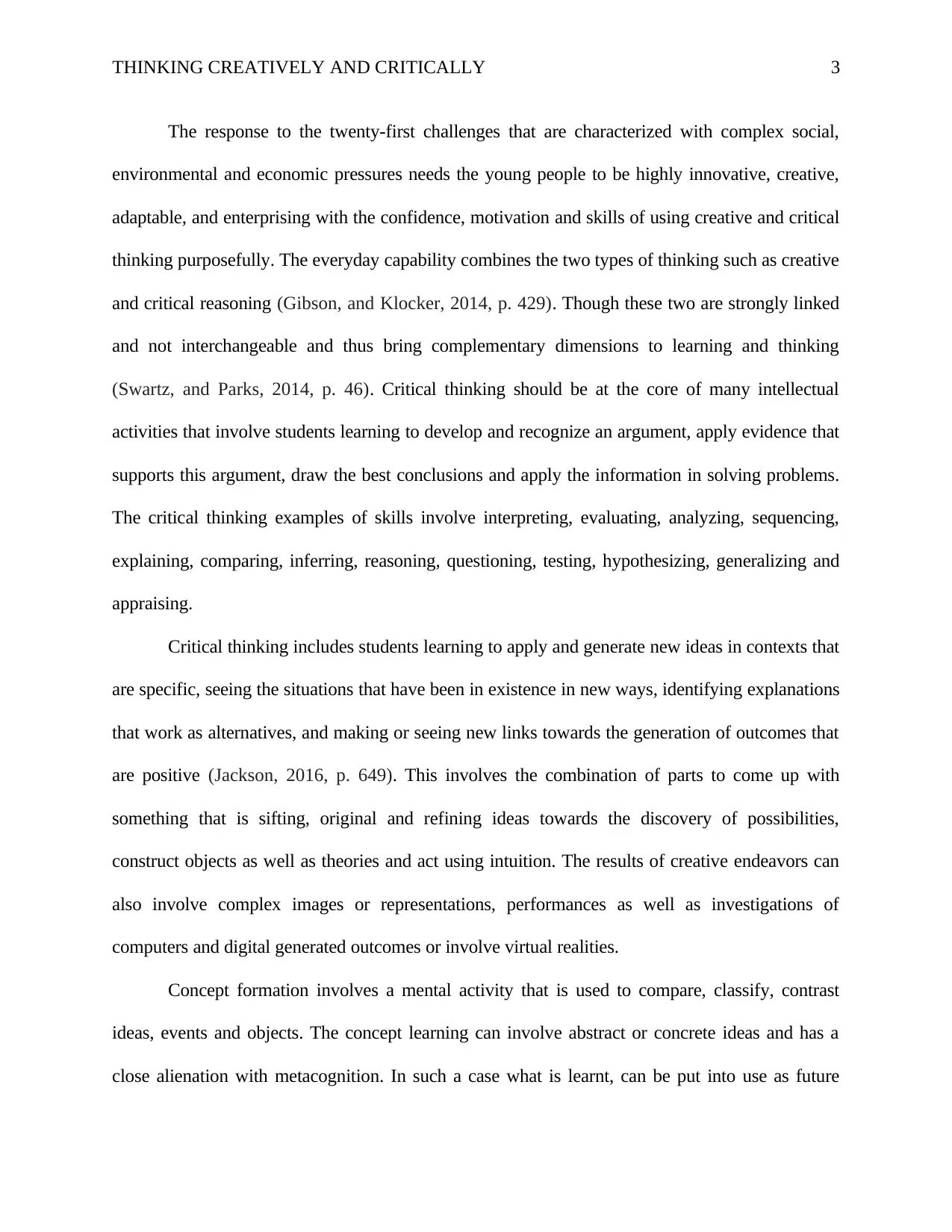
THINKING CREATIVELY AND CRITICALLY 3
The response to the twenty-first challenges that are characterized with complex social,
environmental and economic pressures needs the young people to be highly innovative, creative,
adaptable, and enterprising with the confidence, motivation and skills of using creative and critical
thinking purposefully. The everyday capability combines the two types of thinking such as creative
and critical reasoning (Gibson, and Klocker, 2014, p. 429). Though these two are strongly linked
and not interchangeable and thus bring complementary dimensions to learning and thinking
(Swartz, and Parks, 2014, p. 46). Critical thinking should be at the core of many intellectual
activities that involve students learning to develop and recognize an argument, apply evidence that
supports this argument, draw the best conclusions and apply the information in solving problems.
The critical thinking examples of skills involve interpreting, evaluating, analyzing, sequencing,
explaining, comparing, inferring, reasoning, questioning, testing, hypothesizing, generalizing and
appraising.
Critical thinking includes students learning to apply and generate new ideas in contexts that
are specific, seeing the situations that have been in existence in new ways, identifying explanations
that work as alternatives, and making or seeing new links towards the generation of outcomes that
are positive (Jackson, 2016, p. 649). This involves the combination of parts to come up with
something that is sifting, original and refining ideas towards the discovery of possibilities,
construct objects as well as theories and act using intuition. The results of creative endeavors can
also involve complex images or representations, performances as well as investigations of
computers and digital generated outcomes or involve virtual realities.
Concept formation involves a mental activity that is used to compare, classify, contrast
ideas, events and objects. The concept learning can involve abstract or concrete ideas and has a
close alienation with metacognition. In such a case what is learnt, can be put into use as future
The response to the twenty-first challenges that are characterized with complex social,
environmental and economic pressures needs the young people to be highly innovative, creative,
adaptable, and enterprising with the confidence, motivation and skills of using creative and critical
thinking purposefully. The everyday capability combines the two types of thinking such as creative
and critical reasoning (Gibson, and Klocker, 2014, p. 429). Though these two are strongly linked
and not interchangeable and thus bring complementary dimensions to learning and thinking
(Swartz, and Parks, 2014, p. 46). Critical thinking should be at the core of many intellectual
activities that involve students learning to develop and recognize an argument, apply evidence that
supports this argument, draw the best conclusions and apply the information in solving problems.
The critical thinking examples of skills involve interpreting, evaluating, analyzing, sequencing,
explaining, comparing, inferring, reasoning, questioning, testing, hypothesizing, generalizing and
appraising.
Critical thinking includes students learning to apply and generate new ideas in contexts that
are specific, seeing the situations that have been in existence in new ways, identifying explanations
that work as alternatives, and making or seeing new links towards the generation of outcomes that
are positive (Jackson, 2016, p. 649). This involves the combination of parts to come up with
something that is sifting, original and refining ideas towards the discovery of possibilities,
construct objects as well as theories and act using intuition. The results of creative endeavors can
also involve complex images or representations, performances as well as investigations of
computers and digital generated outcomes or involve virtual realities.
Concept formation involves a mental activity that is used to compare, classify, contrast
ideas, events and objects. The concept learning can involve abstract or concrete ideas and has a
close alienation with metacognition. In such a case what is learnt, can be put into use as future
⊘ This is a preview!⊘
Do you want full access?
Subscribe today to unlock all pages.

Trusted by 1+ million students worldwide
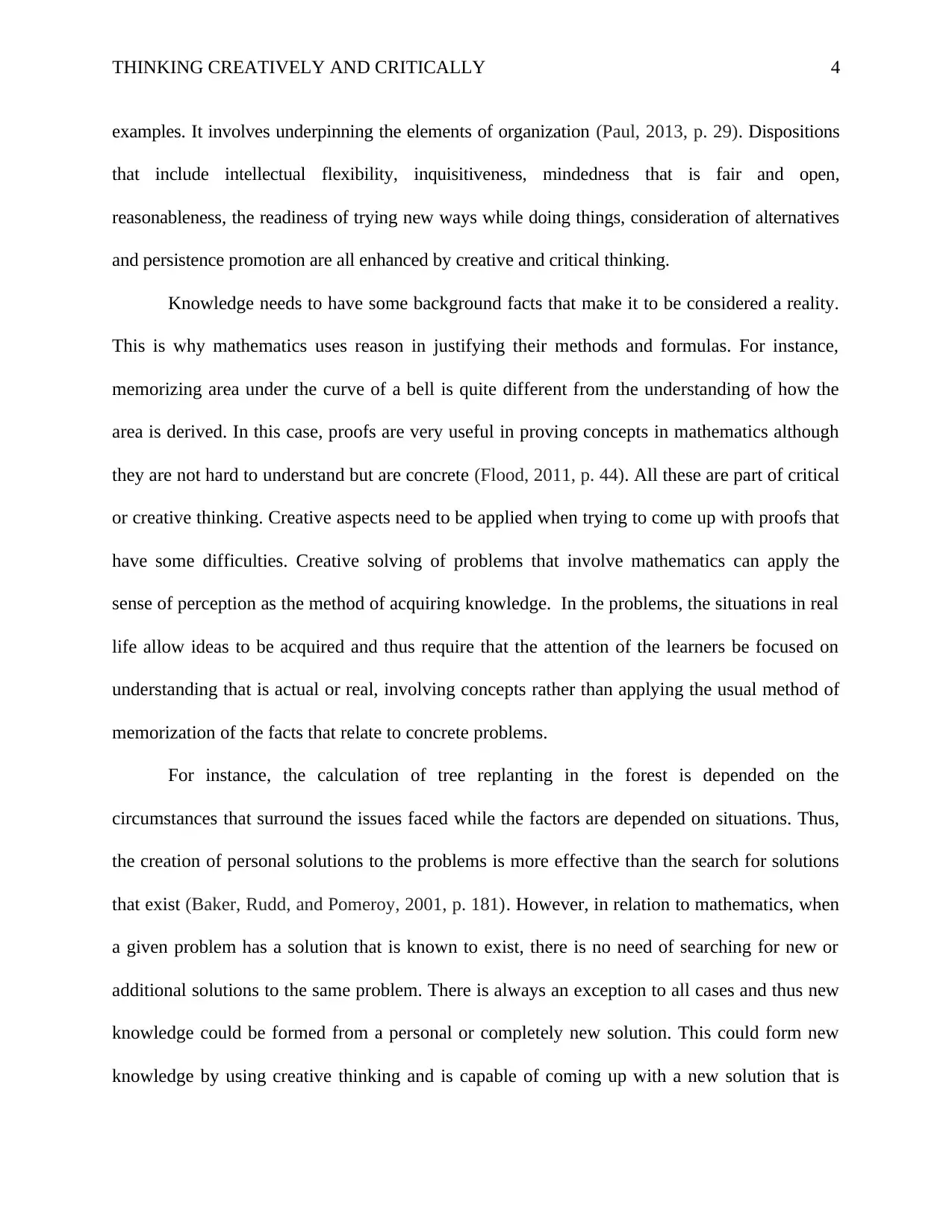
THINKING CREATIVELY AND CRITICALLY 4
examples. It involves underpinning the elements of organization (Paul, 2013, p. 29). Dispositions
that include intellectual flexibility, inquisitiveness, mindedness that is fair and open,
reasonableness, the readiness of trying new ways while doing things, consideration of alternatives
and persistence promotion are all enhanced by creative and critical thinking.
Knowledge needs to have some background facts that make it to be considered a reality.
This is why mathematics uses reason in justifying their methods and formulas. For instance,
memorizing area under the curve of a bell is quite different from the understanding of how the
area is derived. In this case, proofs are very useful in proving concepts in mathematics although
they are not hard to understand but are concrete (Flood, 2011, p. 44). All these are part of critical
or creative thinking. Creative aspects need to be applied when trying to come up with proofs that
have some difficulties. Creative solving of problems that involve mathematics can apply the
sense of perception as the method of acquiring knowledge. In the problems, the situations in real
life allow ideas to be acquired and thus require that the attention of the learners be focused on
understanding that is actual or real, involving concepts rather than applying the usual method of
memorization of the facts that relate to concrete problems.
For instance, the calculation of tree replanting in the forest is depended on the
circumstances that surround the issues faced while the factors are depended on situations. Thus,
the creation of personal solutions to the problems is more effective than the search for solutions
that exist (Baker, Rudd, and Pomeroy, 2001, p. 181). However, in relation to mathematics, when
a given problem has a solution that is known to exist, there is no need of searching for new or
additional solutions to the same problem. There is always an exception to all cases and thus new
knowledge could be formed from a personal or completely new solution. This could form new
knowledge by using creative thinking and is capable of coming up with a new solution that is
examples. It involves underpinning the elements of organization (Paul, 2013, p. 29). Dispositions
that include intellectual flexibility, inquisitiveness, mindedness that is fair and open,
reasonableness, the readiness of trying new ways while doing things, consideration of alternatives
and persistence promotion are all enhanced by creative and critical thinking.
Knowledge needs to have some background facts that make it to be considered a reality.
This is why mathematics uses reason in justifying their methods and formulas. For instance,
memorizing area under the curve of a bell is quite different from the understanding of how the
area is derived. In this case, proofs are very useful in proving concepts in mathematics although
they are not hard to understand but are concrete (Flood, 2011, p. 44). All these are part of critical
or creative thinking. Creative aspects need to be applied when trying to come up with proofs that
have some difficulties. Creative solving of problems that involve mathematics can apply the
sense of perception as the method of acquiring knowledge. In the problems, the situations in real
life allow ideas to be acquired and thus require that the attention of the learners be focused on
understanding that is actual or real, involving concepts rather than applying the usual method of
memorization of the facts that relate to concrete problems.
For instance, the calculation of tree replanting in the forest is depended on the
circumstances that surround the issues faced while the factors are depended on situations. Thus,
the creation of personal solutions to the problems is more effective than the search for solutions
that exist (Baker, Rudd, and Pomeroy, 2001, p. 181). However, in relation to mathematics, when
a given problem has a solution that is known to exist, there is no need of searching for new or
additional solutions to the same problem. There is always an exception to all cases and thus new
knowledge could be formed from a personal or completely new solution. This could form new
knowledge by using creative thinking and is capable of coming up with a new solution that is
Paraphrase This Document
Need a fresh take? Get an instant paraphrase of this document with our AI Paraphraser
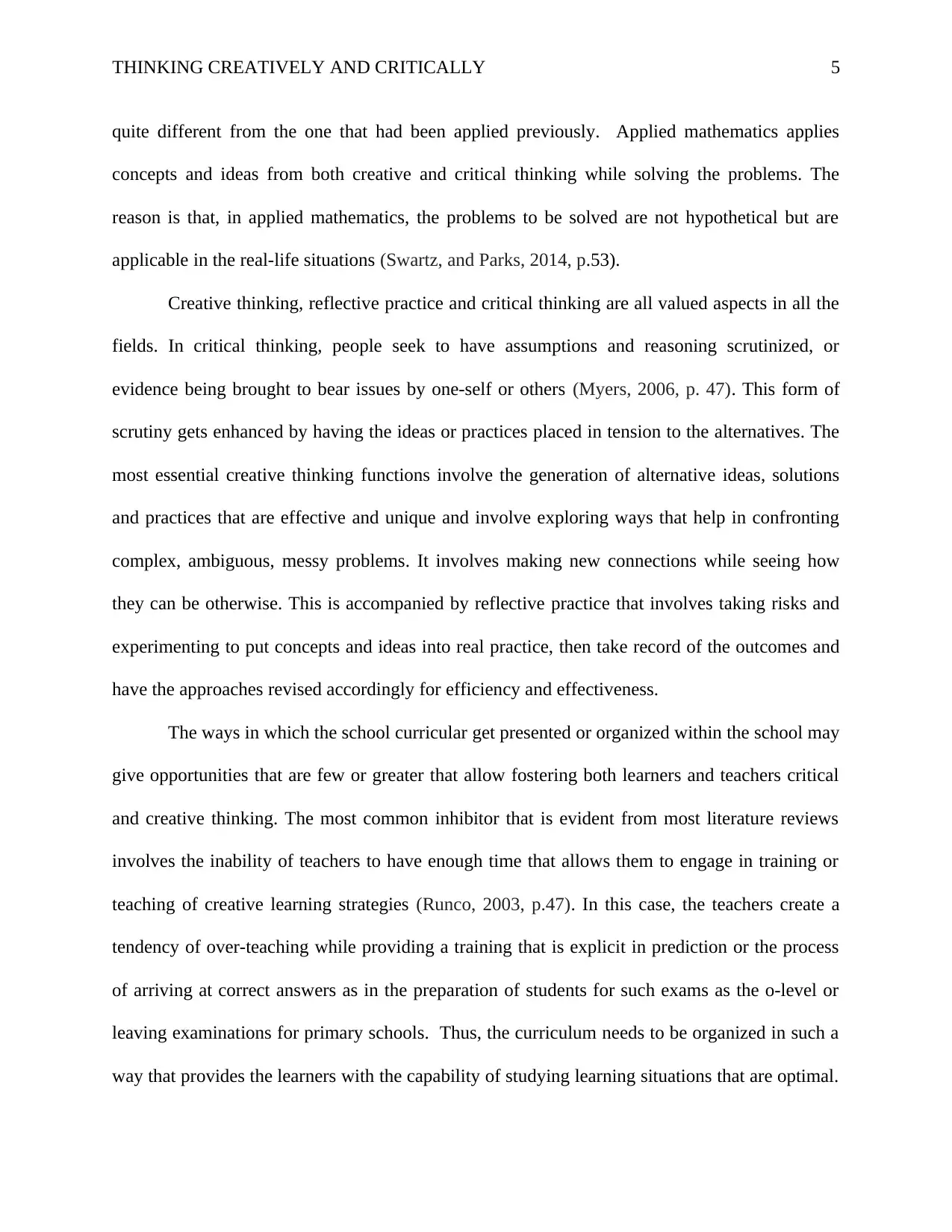
THINKING CREATIVELY AND CRITICALLY 5
quite different from the one that had been applied previously. Applied mathematics applies
concepts and ideas from both creative and critical thinking while solving the problems. The
reason is that, in applied mathematics, the problems to be solved are not hypothetical but are
applicable in the real-life situations (Swartz, and Parks, 2014, p.53).
Creative thinking, reflective practice and critical thinking are all valued aspects in all the
fields. In critical thinking, people seek to have assumptions and reasoning scrutinized, or
evidence being brought to bear issues by one-self or others (Myers, 2006, p. 47). This form of
scrutiny gets enhanced by having the ideas or practices placed in tension to the alternatives. The
most essential creative thinking functions involve the generation of alternative ideas, solutions
and practices that are effective and unique and involve exploring ways that help in confronting
complex, ambiguous, messy problems. It involves making new connections while seeing how
they can be otherwise. This is accompanied by reflective practice that involves taking risks and
experimenting to put concepts and ideas into real practice, then take record of the outcomes and
have the approaches revised accordingly for efficiency and effectiveness.
The ways in which the school curricular get presented or organized within the school may
give opportunities that are few or greater that allow fostering both learners and teachers critical
and creative thinking. The most common inhibitor that is evident from most literature reviews
involves the inability of teachers to have enough time that allows them to engage in training or
teaching of creative learning strategies (Runco, 2003, p.47). In this case, the teachers create a
tendency of over-teaching while providing a training that is explicit in prediction or the process
of arriving at correct answers as in the preparation of students for such exams as the o-level or
leaving examinations for primary schools. Thus, the curriculum needs to be organized in such a
way that provides the learners with the capability of studying learning situations that are optimal.
quite different from the one that had been applied previously. Applied mathematics applies
concepts and ideas from both creative and critical thinking while solving the problems. The
reason is that, in applied mathematics, the problems to be solved are not hypothetical but are
applicable in the real-life situations (Swartz, and Parks, 2014, p.53).
Creative thinking, reflective practice and critical thinking are all valued aspects in all the
fields. In critical thinking, people seek to have assumptions and reasoning scrutinized, or
evidence being brought to bear issues by one-self or others (Myers, 2006, p. 47). This form of
scrutiny gets enhanced by having the ideas or practices placed in tension to the alternatives. The
most essential creative thinking functions involve the generation of alternative ideas, solutions
and practices that are effective and unique and involve exploring ways that help in confronting
complex, ambiguous, messy problems. It involves making new connections while seeing how
they can be otherwise. This is accompanied by reflective practice that involves taking risks and
experimenting to put concepts and ideas into real practice, then take record of the outcomes and
have the approaches revised accordingly for efficiency and effectiveness.
The ways in which the school curricular get presented or organized within the school may
give opportunities that are few or greater that allow fostering both learners and teachers critical
and creative thinking. The most common inhibitor that is evident from most literature reviews
involves the inability of teachers to have enough time that allows them to engage in training or
teaching of creative learning strategies (Runco, 2003, p.47). In this case, the teachers create a
tendency of over-teaching while providing a training that is explicit in prediction or the process
of arriving at correct answers as in the preparation of students for such exams as the o-level or
leaving examinations for primary schools. Thus, the curriculum needs to be organized in such a
way that provides the learners with the capability of studying learning situations that are optimal.
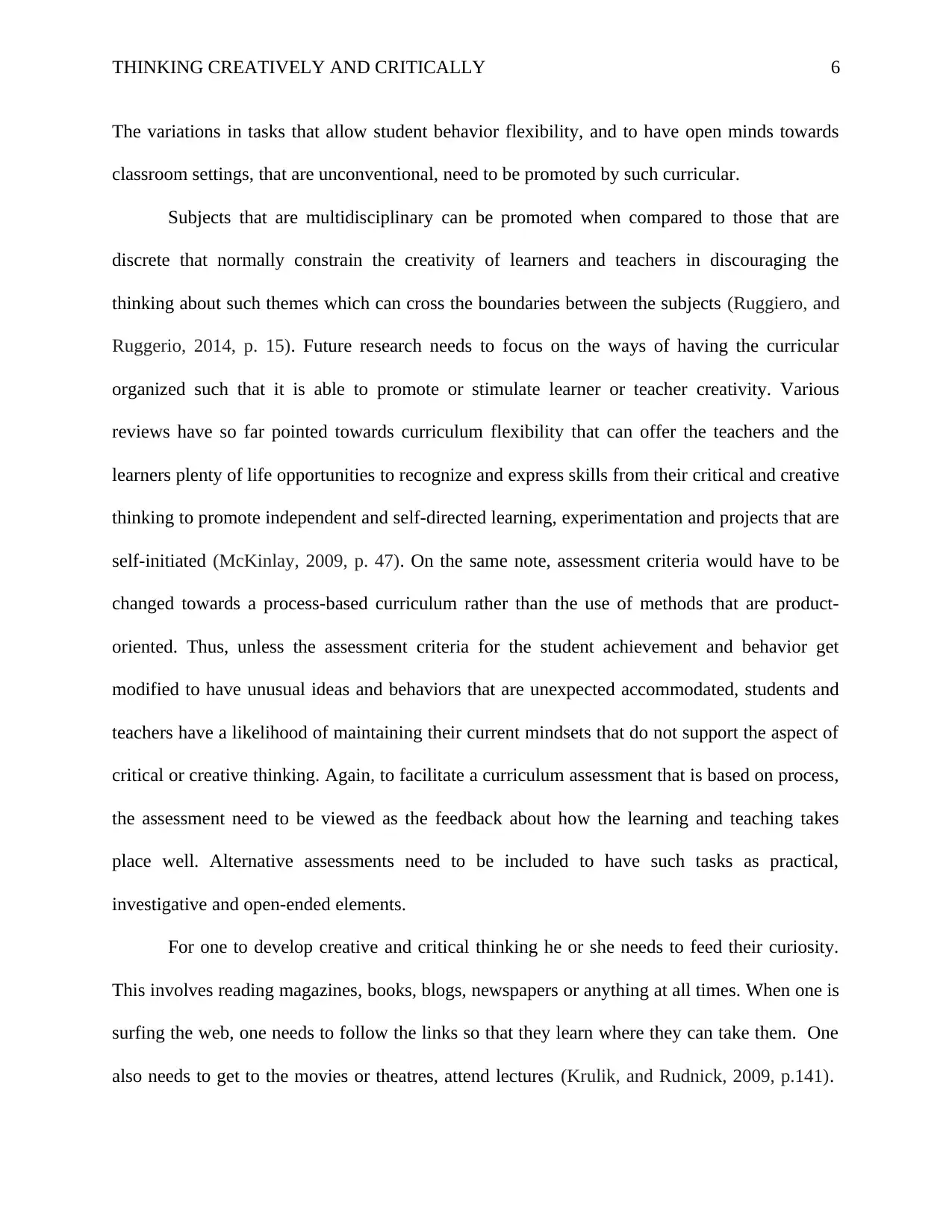
THINKING CREATIVELY AND CRITICALLY 6
The variations in tasks that allow student behavior flexibility, and to have open minds towards
classroom settings, that are unconventional, need to be promoted by such curricular.
Subjects that are multidisciplinary can be promoted when compared to those that are
discrete that normally constrain the creativity of learners and teachers in discouraging the
thinking about such themes which can cross the boundaries between the subjects (Ruggiero, and
Ruggerio, 2014, p. 15). Future research needs to focus on the ways of having the curricular
organized such that it is able to promote or stimulate learner or teacher creativity. Various
reviews have so far pointed towards curriculum flexibility that can offer the teachers and the
learners plenty of life opportunities to recognize and express skills from their critical and creative
thinking to promote independent and self-directed learning, experimentation and projects that are
self-initiated (McKinlay, 2009, p. 47). On the same note, assessment criteria would have to be
changed towards a process-based curriculum rather than the use of methods that are product-
oriented. Thus, unless the assessment criteria for the student achievement and behavior get
modified to have unusual ideas and behaviors that are unexpected accommodated, students and
teachers have a likelihood of maintaining their current mindsets that do not support the aspect of
critical or creative thinking. Again, to facilitate a curriculum assessment that is based on process,
the assessment need to be viewed as the feedback about how the learning and teaching takes
place well. Alternative assessments need to be included to have such tasks as practical,
investigative and open-ended elements.
For one to develop creative and critical thinking he or she needs to feed their curiosity.
This involves reading magazines, books, blogs, newspapers or anything at all times. When one is
surfing the web, one needs to follow the links so that they learn where they can take them. One
also needs to get to the movies or theatres, attend lectures (Krulik, and Rudnick, 2009, p.141).
The variations in tasks that allow student behavior flexibility, and to have open minds towards
classroom settings, that are unconventional, need to be promoted by such curricular.
Subjects that are multidisciplinary can be promoted when compared to those that are
discrete that normally constrain the creativity of learners and teachers in discouraging the
thinking about such themes which can cross the boundaries between the subjects (Ruggiero, and
Ruggerio, 2014, p. 15). Future research needs to focus on the ways of having the curricular
organized such that it is able to promote or stimulate learner or teacher creativity. Various
reviews have so far pointed towards curriculum flexibility that can offer the teachers and the
learners plenty of life opportunities to recognize and express skills from their critical and creative
thinking to promote independent and self-directed learning, experimentation and projects that are
self-initiated (McKinlay, 2009, p. 47). On the same note, assessment criteria would have to be
changed towards a process-based curriculum rather than the use of methods that are product-
oriented. Thus, unless the assessment criteria for the student achievement and behavior get
modified to have unusual ideas and behaviors that are unexpected accommodated, students and
teachers have a likelihood of maintaining their current mindsets that do not support the aspect of
critical or creative thinking. Again, to facilitate a curriculum assessment that is based on process,
the assessment need to be viewed as the feedback about how the learning and teaching takes
place well. Alternative assessments need to be included to have such tasks as practical,
investigative and open-ended elements.
For one to develop creative and critical thinking he or she needs to feed their curiosity.
This involves reading magazines, books, blogs, newspapers or anything at all times. When one is
surfing the web, one needs to follow the links so that they learn where they can take them. One
also needs to get to the movies or theatres, attend lectures (Krulik, and Rudnick, 2009, p.141).
⊘ This is a preview!⊘
Do you want full access?
Subscribe today to unlock all pages.

Trusted by 1+ million students worldwide
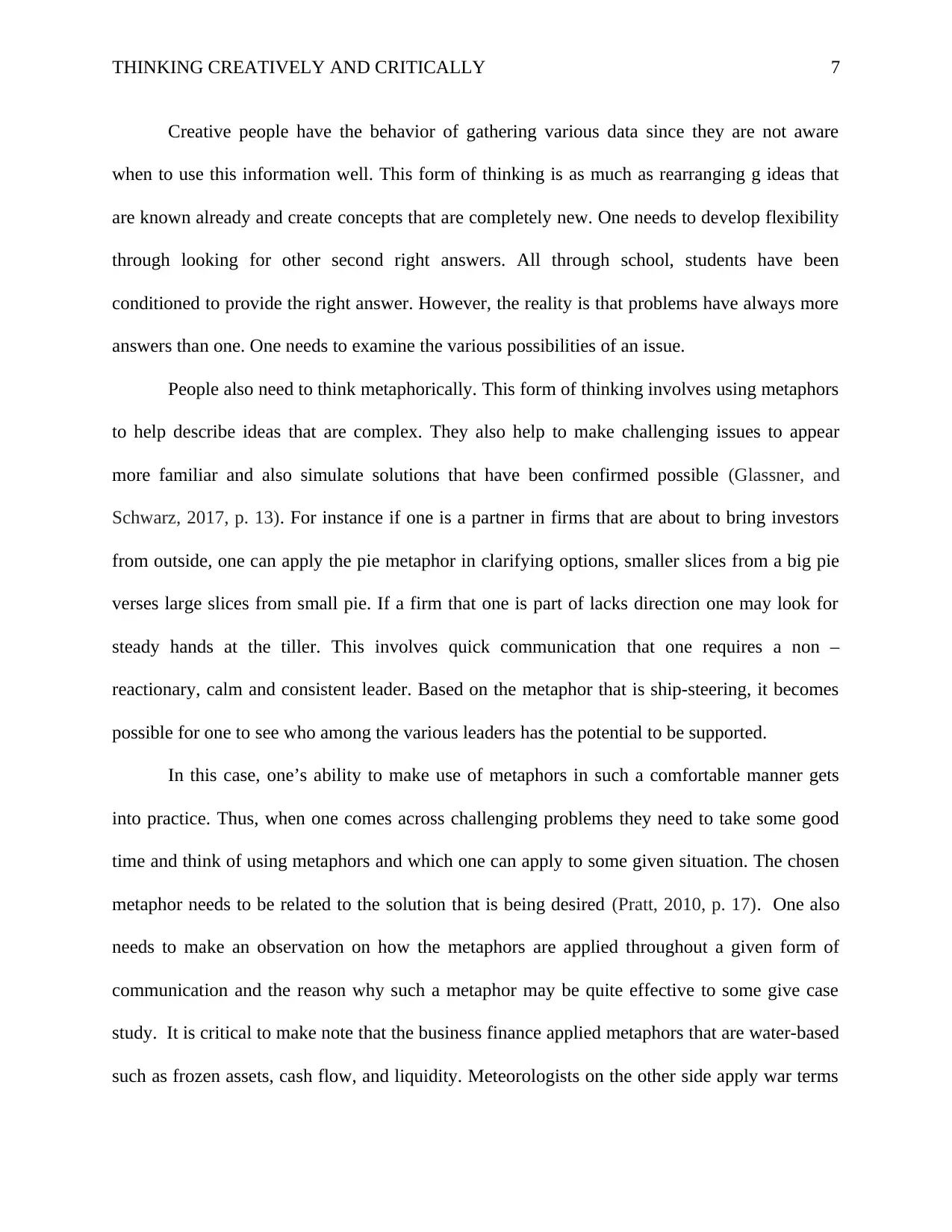
THINKING CREATIVELY AND CRITICALLY 7
Creative people have the behavior of gathering various data since they are not aware
when to use this information well. This form of thinking is as much as rearranging g ideas that
are known already and create concepts that are completely new. One needs to develop flexibility
through looking for other second right answers. All through school, students have been
conditioned to provide the right answer. However, the reality is that problems have always more
answers than one. One needs to examine the various possibilities of an issue.
People also need to think metaphorically. This form of thinking involves using metaphors
to help describe ideas that are complex. They also help to make challenging issues to appear
more familiar and also simulate solutions that have been confirmed possible (Glassner, and
Schwarz, 2017, p. 13). For instance if one is a partner in firms that are about to bring investors
from outside, one can apply the pie metaphor in clarifying options, smaller slices from a big pie
verses large slices from small pie. If a firm that one is part of lacks direction one may look for
steady hands at the tiller. This involves quick communication that one requires a non –
reactionary, calm and consistent leader. Based on the metaphor that is ship-steering, it becomes
possible for one to see who among the various leaders has the potential to be supported.
In this case, one’s ability to make use of metaphors in such a comfortable manner gets
into practice. Thus, when one comes across challenging problems they need to take some good
time and think of using metaphors and which one can apply to some given situation. The chosen
metaphor needs to be related to the solution that is being desired (Pratt, 2010, p. 17). One also
needs to make an observation on how the metaphors are applied throughout a given form of
communication and the reason why such a metaphor may be quite effective to some give case
study. It is critical to make note that the business finance applied metaphors that are water-based
such as frozen assets, cash flow, and liquidity. Meteorologists on the other side apply war terms
Creative people have the behavior of gathering various data since they are not aware
when to use this information well. This form of thinking is as much as rearranging g ideas that
are known already and create concepts that are completely new. One needs to develop flexibility
through looking for other second right answers. All through school, students have been
conditioned to provide the right answer. However, the reality is that problems have always more
answers than one. One needs to examine the various possibilities of an issue.
People also need to think metaphorically. This form of thinking involves using metaphors
to help describe ideas that are complex. They also help to make challenging issues to appear
more familiar and also simulate solutions that have been confirmed possible (Glassner, and
Schwarz, 2017, p. 13). For instance if one is a partner in firms that are about to bring investors
from outside, one can apply the pie metaphor in clarifying options, smaller slices from a big pie
verses large slices from small pie. If a firm that one is part of lacks direction one may look for
steady hands at the tiller. This involves quick communication that one requires a non –
reactionary, calm and consistent leader. Based on the metaphor that is ship-steering, it becomes
possible for one to see who among the various leaders has the potential to be supported.
In this case, one’s ability to make use of metaphors in such a comfortable manner gets
into practice. Thus, when one comes across challenging problems they need to take some good
time and think of using metaphors and which one can apply to some given situation. The chosen
metaphor needs to be related to the solution that is being desired (Pratt, 2010, p. 17). One also
needs to make an observation on how the metaphors are applied throughout a given form of
communication and the reason why such a metaphor may be quite effective to some give case
study. It is critical to make note that the business finance applied metaphors that are water-based
such as frozen assets, cash flow, and liquidity. Meteorologists on the other side apply war terms
Paraphrase This Document
Need a fresh take? Get an instant paraphrase of this document with our AI Paraphraser
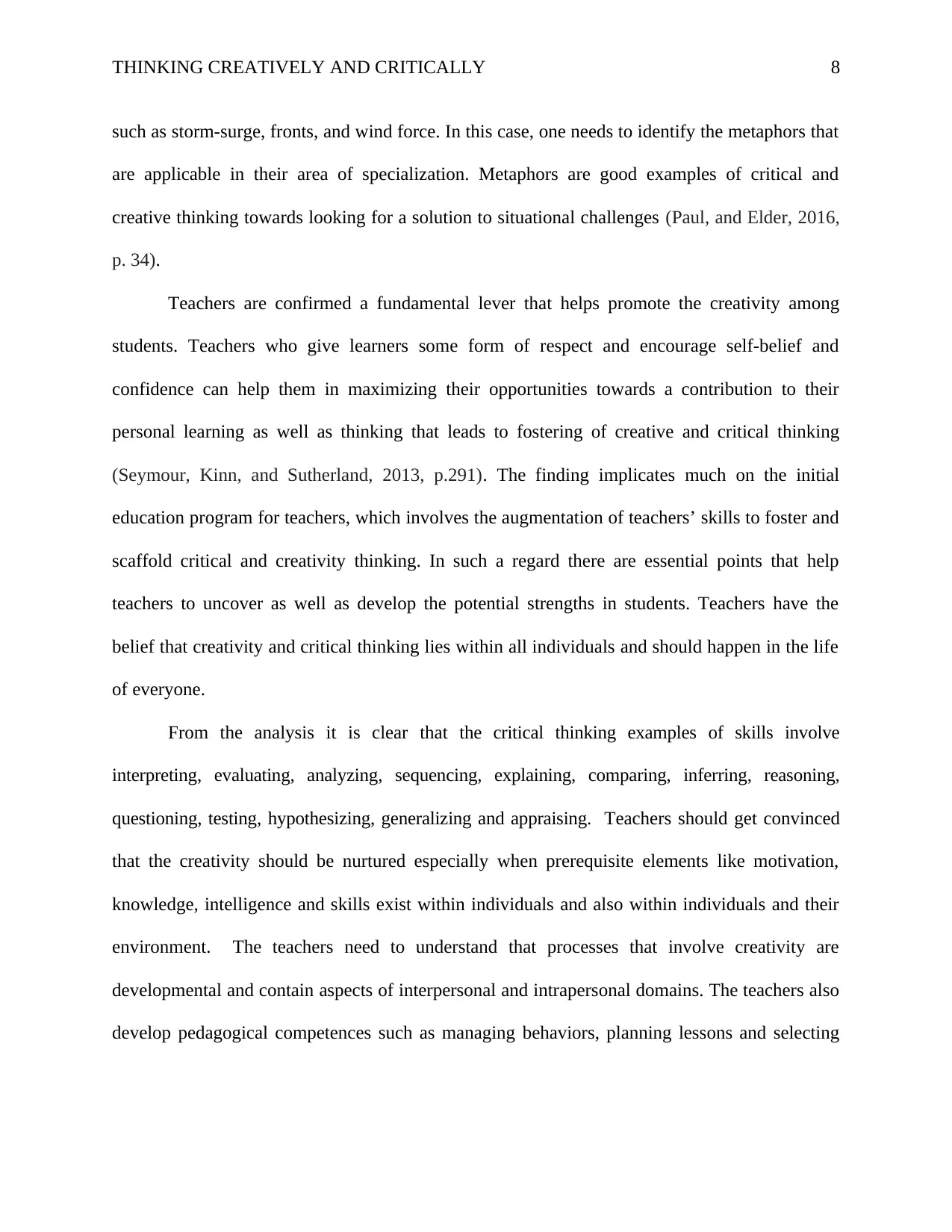
THINKING CREATIVELY AND CRITICALLY 8
such as storm-surge, fronts, and wind force. In this case, one needs to identify the metaphors that
are applicable in their area of specialization. Metaphors are good examples of critical and
creative thinking towards looking for a solution to situational challenges (Paul, and Elder, 2016,
p. 34).
Teachers are confirmed a fundamental lever that helps promote the creativity among
students. Teachers who give learners some form of respect and encourage self-belief and
confidence can help them in maximizing their opportunities towards a contribution to their
personal learning as well as thinking that leads to fostering of creative and critical thinking
(Seymour, Kinn, and Sutherland, 2013, p.291). The finding implicates much on the initial
education program for teachers, which involves the augmentation of teachers’ skills to foster and
scaffold critical and creativity thinking. In such a regard there are essential points that help
teachers to uncover as well as develop the potential strengths in students. Teachers have the
belief that creativity and critical thinking lies within all individuals and should happen in the life
of everyone.
From the analysis it is clear that the critical thinking examples of skills involve
interpreting, evaluating, analyzing, sequencing, explaining, comparing, inferring, reasoning,
questioning, testing, hypothesizing, generalizing and appraising. Teachers should get convinced
that the creativity should be nurtured especially when prerequisite elements like motivation,
knowledge, intelligence and skills exist within individuals and also within individuals and their
environment. The teachers need to understand that processes that involve creativity are
developmental and contain aspects of interpersonal and intrapersonal domains. The teachers also
develop pedagogical competences such as managing behaviors, planning lessons and selecting
such as storm-surge, fronts, and wind force. In this case, one needs to identify the metaphors that
are applicable in their area of specialization. Metaphors are good examples of critical and
creative thinking towards looking for a solution to situational challenges (Paul, and Elder, 2016,
p. 34).
Teachers are confirmed a fundamental lever that helps promote the creativity among
students. Teachers who give learners some form of respect and encourage self-belief and
confidence can help them in maximizing their opportunities towards a contribution to their
personal learning as well as thinking that leads to fostering of creative and critical thinking
(Seymour, Kinn, and Sutherland, 2013, p.291). The finding implicates much on the initial
education program for teachers, which involves the augmentation of teachers’ skills to foster and
scaffold critical and creativity thinking. In such a regard there are essential points that help
teachers to uncover as well as develop the potential strengths in students. Teachers have the
belief that creativity and critical thinking lies within all individuals and should happen in the life
of everyone.
From the analysis it is clear that the critical thinking examples of skills involve
interpreting, evaluating, analyzing, sequencing, explaining, comparing, inferring, reasoning,
questioning, testing, hypothesizing, generalizing and appraising. Teachers should get convinced
that the creativity should be nurtured especially when prerequisite elements like motivation,
knowledge, intelligence and skills exist within individuals and also within individuals and their
environment. The teachers need to understand that processes that involve creativity are
developmental and contain aspects of interpersonal and intrapersonal domains. The teachers also
develop pedagogical competences such as managing behaviors, planning lessons and selecting
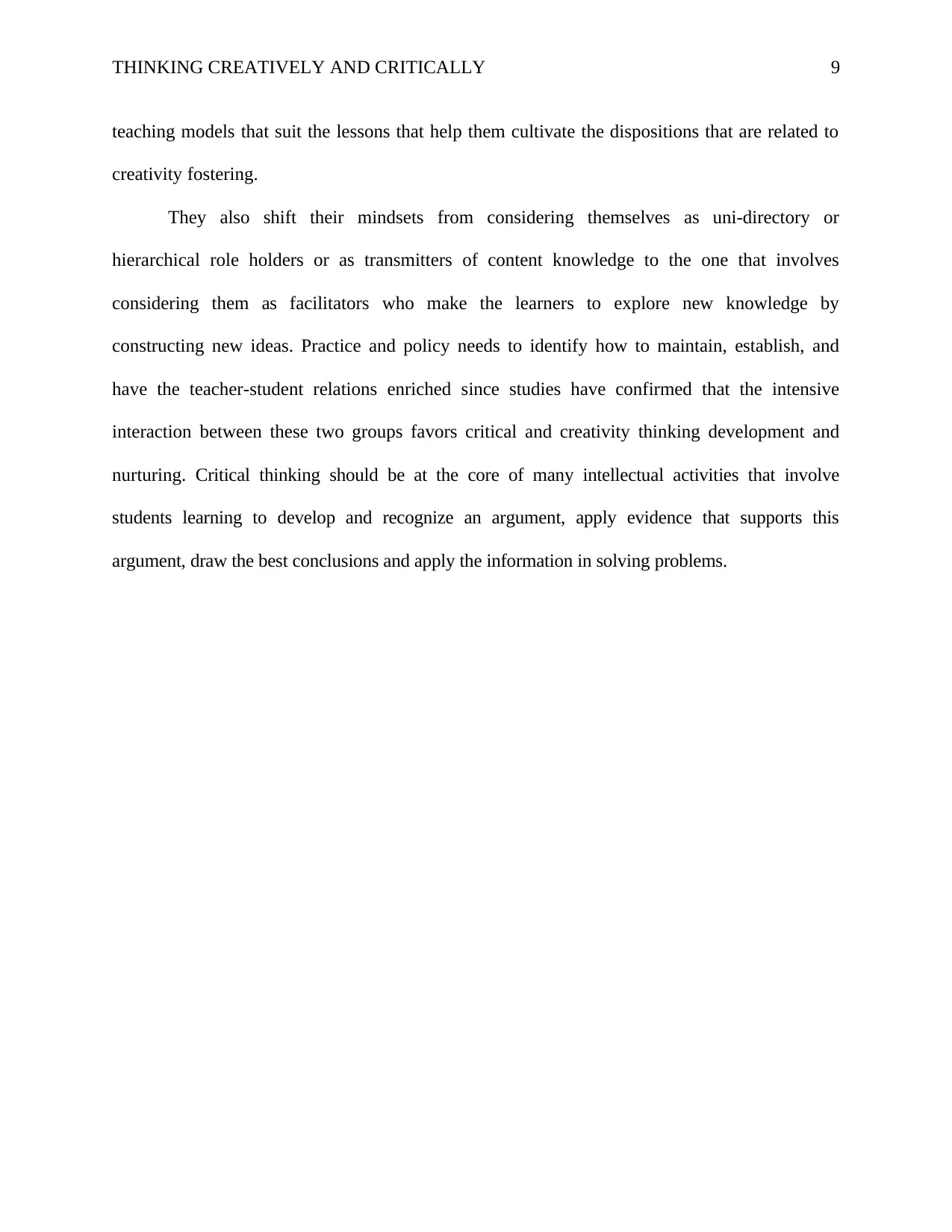
THINKING CREATIVELY AND CRITICALLY 9
teaching models that suit the lessons that help them cultivate the dispositions that are related to
creativity fostering.
They also shift their mindsets from considering themselves as uni-directory or
hierarchical role holders or as transmitters of content knowledge to the one that involves
considering them as facilitators who make the learners to explore new knowledge by
constructing new ideas. Practice and policy needs to identify how to maintain, establish, and
have the teacher-student relations enriched since studies have confirmed that the intensive
interaction between these two groups favors critical and creativity thinking development and
nurturing. Critical thinking should be at the core of many intellectual activities that involve
students learning to develop and recognize an argument, apply evidence that supports this
argument, draw the best conclusions and apply the information in solving problems.
teaching models that suit the lessons that help them cultivate the dispositions that are related to
creativity fostering.
They also shift their mindsets from considering themselves as uni-directory or
hierarchical role holders or as transmitters of content knowledge to the one that involves
considering them as facilitators who make the learners to explore new knowledge by
constructing new ideas. Practice and policy needs to identify how to maintain, establish, and
have the teacher-student relations enriched since studies have confirmed that the intensive
interaction between these two groups favors critical and creativity thinking development and
nurturing. Critical thinking should be at the core of many intellectual activities that involve
students learning to develop and recognize an argument, apply evidence that supports this
argument, draw the best conclusions and apply the information in solving problems.
⊘ This is a preview!⊘
Do you want full access?
Subscribe today to unlock all pages.

Trusted by 1+ million students worldwide
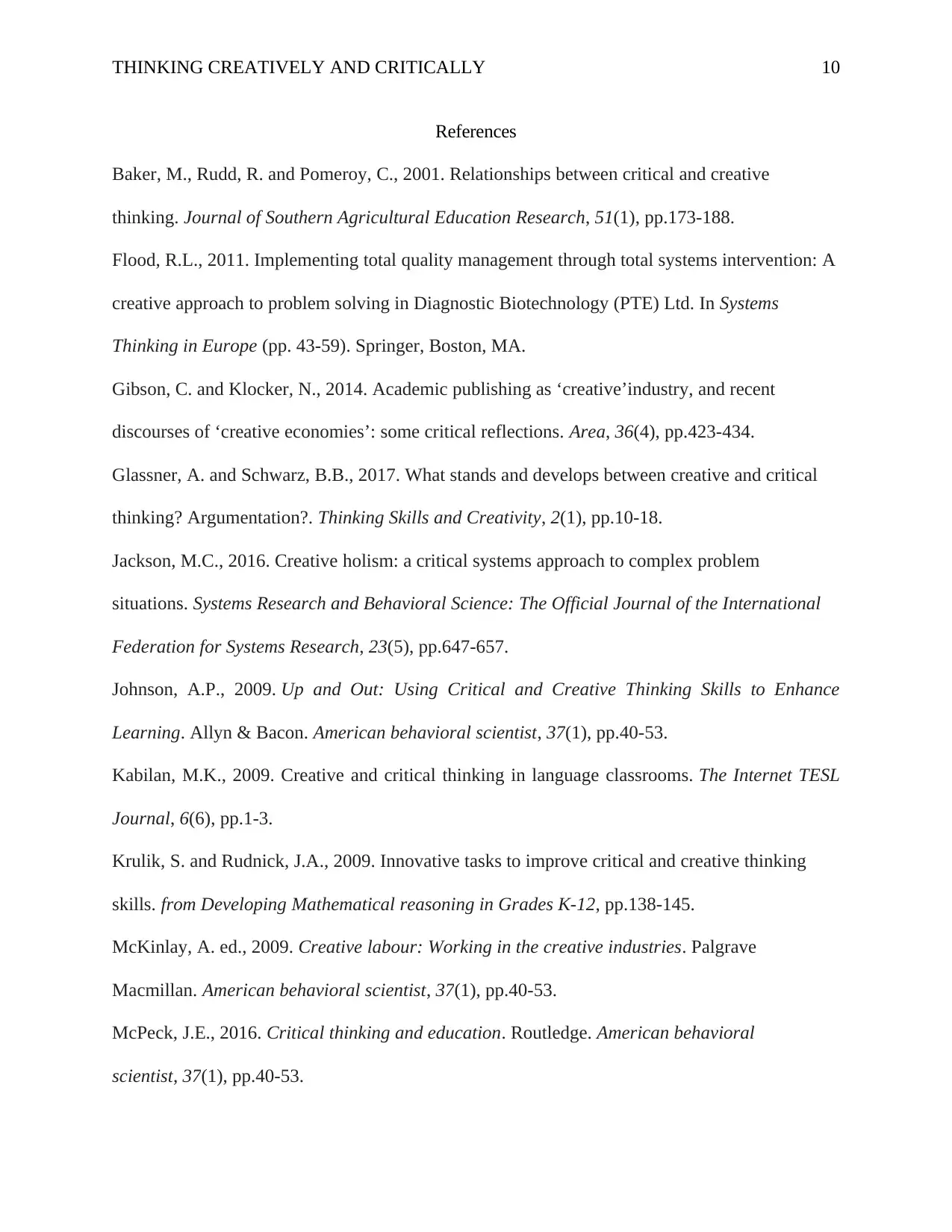
THINKING CREATIVELY AND CRITICALLY 10
References
Baker, M., Rudd, R. and Pomeroy, C., 2001. Relationships between critical and creative
thinking. Journal of Southern Agricultural Education Research, 51(1), pp.173-188.
Flood, R.L., 2011. Implementing total quality management through total systems intervention: A
creative approach to problem solving in Diagnostic Biotechnology (PTE) Ltd. In Systems
Thinking in Europe (pp. 43-59). Springer, Boston, MA.
Gibson, C. and Klocker, N., 2014. Academic publishing as ‘creative’industry, and recent
discourses of ‘creative economies’: some critical reflections. Area, 36(4), pp.423-434.
Glassner, A. and Schwarz, B.B., 2017. What stands and develops between creative and critical
thinking? Argumentation?. Thinking Skills and Creativity, 2(1), pp.10-18.
Jackson, M.C., 2016. Creative holism: a critical systems approach to complex problem
situations. Systems Research and Behavioral Science: The Official Journal of the International
Federation for Systems Research, 23(5), pp.647-657.
Johnson, A.P., 2009. Up and Out: Using Critical and Creative Thinking Skills to Enhance
Learning. Allyn & Bacon. American behavioral scientist, 37(1), pp.40-53.
Kabilan, M.K., 2009. Creative and critical thinking in language classrooms. The Internet TESL
Journal, 6(6), pp.1-3.
Krulik, S. and Rudnick, J.A., 2009. Innovative tasks to improve critical and creative thinking
skills. from Developing Mathematical reasoning in Grades K-12, pp.138-145.
McKinlay, A. ed., 2009. Creative labour: Working in the creative industries. Palgrave
Macmillan. American behavioral scientist, 37(1), pp.40-53.
McPeck, J.E., 2016. Critical thinking and education. Routledge. American behavioral
scientist, 37(1), pp.40-53.
References
Baker, M., Rudd, R. and Pomeroy, C., 2001. Relationships between critical and creative
thinking. Journal of Southern Agricultural Education Research, 51(1), pp.173-188.
Flood, R.L., 2011. Implementing total quality management through total systems intervention: A
creative approach to problem solving in Diagnostic Biotechnology (PTE) Ltd. In Systems
Thinking in Europe (pp. 43-59). Springer, Boston, MA.
Gibson, C. and Klocker, N., 2014. Academic publishing as ‘creative’industry, and recent
discourses of ‘creative economies’: some critical reflections. Area, 36(4), pp.423-434.
Glassner, A. and Schwarz, B.B., 2017. What stands and develops between creative and critical
thinking? Argumentation?. Thinking Skills and Creativity, 2(1), pp.10-18.
Jackson, M.C., 2016. Creative holism: a critical systems approach to complex problem
situations. Systems Research and Behavioral Science: The Official Journal of the International
Federation for Systems Research, 23(5), pp.647-657.
Johnson, A.P., 2009. Up and Out: Using Critical and Creative Thinking Skills to Enhance
Learning. Allyn & Bacon. American behavioral scientist, 37(1), pp.40-53.
Kabilan, M.K., 2009. Creative and critical thinking in language classrooms. The Internet TESL
Journal, 6(6), pp.1-3.
Krulik, S. and Rudnick, J.A., 2009. Innovative tasks to improve critical and creative thinking
skills. from Developing Mathematical reasoning in Grades K-12, pp.138-145.
McKinlay, A. ed., 2009. Creative labour: Working in the creative industries. Palgrave
Macmillan. American behavioral scientist, 37(1), pp.40-53.
McPeck, J.E., 2016. Critical thinking and education. Routledge. American behavioral
scientist, 37(1), pp.40-53.
Paraphrase This Document
Need a fresh take? Get an instant paraphrase of this document with our AI Paraphraser
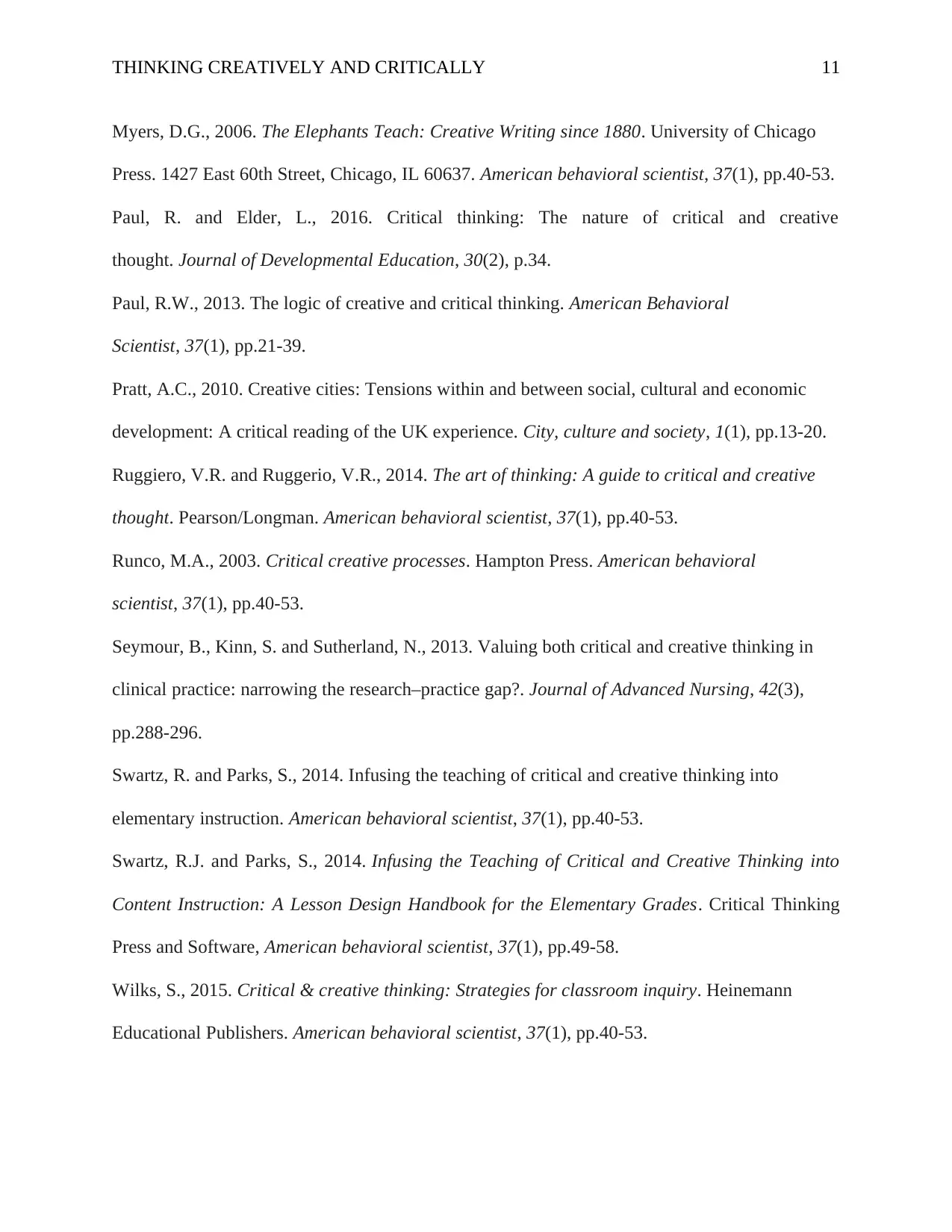
THINKING CREATIVELY AND CRITICALLY 11
Myers, D.G., 2006. The Elephants Teach: Creative Writing since 1880. University of Chicago
Press. 1427 East 60th Street, Chicago, IL 60637. American behavioral scientist, 37(1), pp.40-53.
Paul, R. and Elder, L., 2016. Critical thinking: The nature of critical and creative
thought. Journal of Developmental Education, 30(2), p.34.
Paul, R.W., 2013. The logic of creative and critical thinking. American Behavioral
Scientist, 37(1), pp.21-39.
Pratt, A.C., 2010. Creative cities: Tensions within and between social, cultural and economic
development: A critical reading of the UK experience. City, culture and society, 1(1), pp.13-20.
Ruggiero, V.R. and Ruggerio, V.R., 2014. The art of thinking: A guide to critical and creative
thought. Pearson/Longman. American behavioral scientist, 37(1), pp.40-53.
Runco, M.A., 2003. Critical creative processes. Hampton Press. American behavioral
scientist, 37(1), pp.40-53.
Seymour, B., Kinn, S. and Sutherland, N., 2013. Valuing both critical and creative thinking in
clinical practice: narrowing the research–practice gap?. Journal of Advanced Nursing, 42(3),
pp.288-296.
Swartz, R. and Parks, S., 2014. Infusing the teaching of critical and creative thinking into
elementary instruction. American behavioral scientist, 37(1), pp.40-53.
Swartz, R.J. and Parks, S., 2014. Infusing the Teaching of Critical and Creative Thinking into
Content Instruction: A Lesson Design Handbook for the Elementary Grades. Critical Thinking
Press and Software, American behavioral scientist, 37(1), pp.49-58.
Wilks, S., 2015. Critical & creative thinking: Strategies for classroom inquiry. Heinemann
Educational Publishers. American behavioral scientist, 37(1), pp.40-53.
Myers, D.G., 2006. The Elephants Teach: Creative Writing since 1880. University of Chicago
Press. 1427 East 60th Street, Chicago, IL 60637. American behavioral scientist, 37(1), pp.40-53.
Paul, R. and Elder, L., 2016. Critical thinking: The nature of critical and creative
thought. Journal of Developmental Education, 30(2), p.34.
Paul, R.W., 2013. The logic of creative and critical thinking. American Behavioral
Scientist, 37(1), pp.21-39.
Pratt, A.C., 2010. Creative cities: Tensions within and between social, cultural and economic
development: A critical reading of the UK experience. City, culture and society, 1(1), pp.13-20.
Ruggiero, V.R. and Ruggerio, V.R., 2014. The art of thinking: A guide to critical and creative
thought. Pearson/Longman. American behavioral scientist, 37(1), pp.40-53.
Runco, M.A., 2003. Critical creative processes. Hampton Press. American behavioral
scientist, 37(1), pp.40-53.
Seymour, B., Kinn, S. and Sutherland, N., 2013. Valuing both critical and creative thinking in
clinical practice: narrowing the research–practice gap?. Journal of Advanced Nursing, 42(3),
pp.288-296.
Swartz, R. and Parks, S., 2014. Infusing the teaching of critical and creative thinking into
elementary instruction. American behavioral scientist, 37(1), pp.40-53.
Swartz, R.J. and Parks, S., 2014. Infusing the Teaching of Critical and Creative Thinking into
Content Instruction: A Lesson Design Handbook for the Elementary Grades. Critical Thinking
Press and Software, American behavioral scientist, 37(1), pp.49-58.
Wilks, S., 2015. Critical & creative thinking: Strategies for classroom inquiry. Heinemann
Educational Publishers. American behavioral scientist, 37(1), pp.40-53.
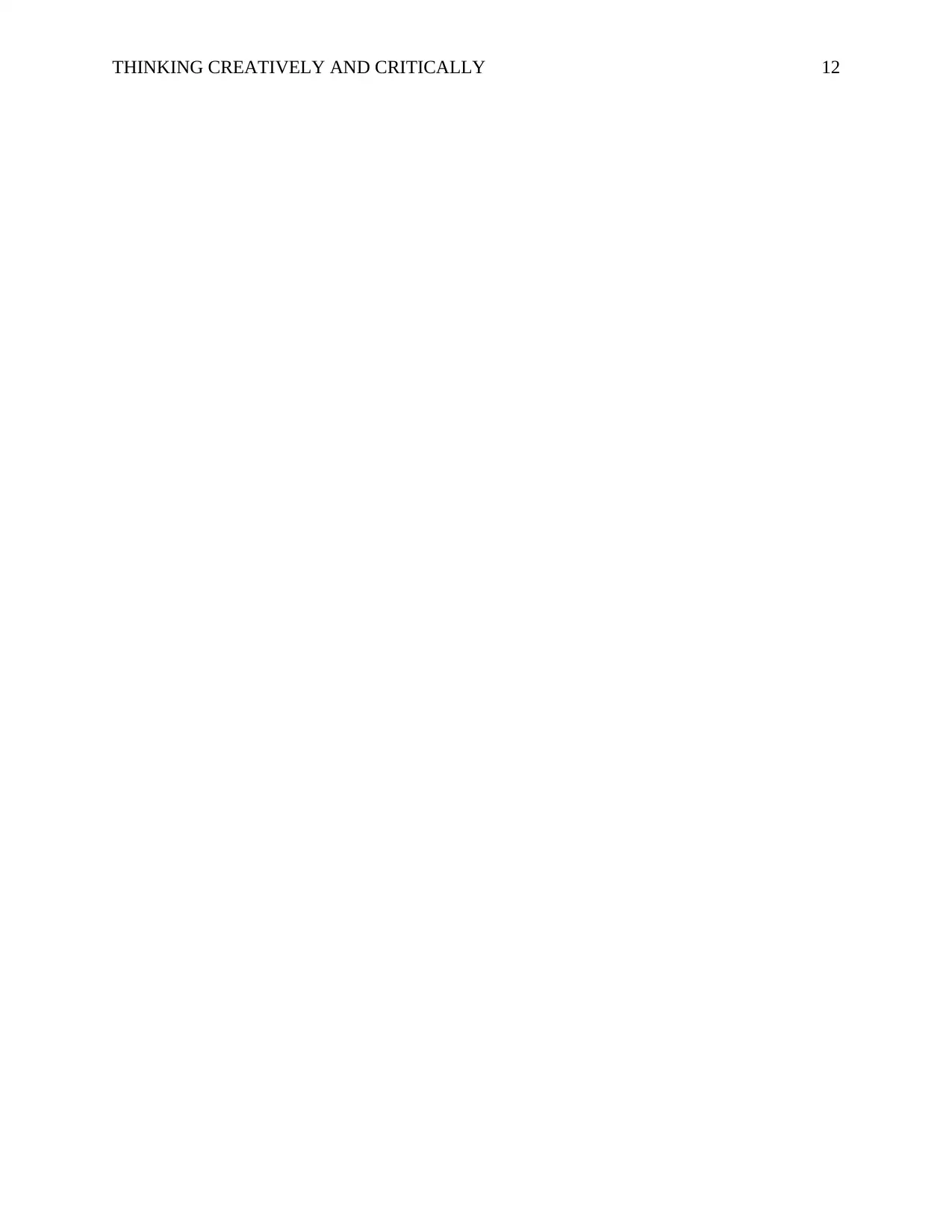
THINKING CREATIVELY AND CRITICALLY 12
⊘ This is a preview!⊘
Do you want full access?
Subscribe today to unlock all pages.

Trusted by 1+ million students worldwide
1 out of 12
Related Documents
Your All-in-One AI-Powered Toolkit for Academic Success.
+13062052269
info@desklib.com
Available 24*7 on WhatsApp / Email
![[object Object]](/_next/static/media/star-bottom.7253800d.svg)
Unlock your academic potential
Copyright © 2020–2025 A2Z Services. All Rights Reserved. Developed and managed by ZUCOL.





